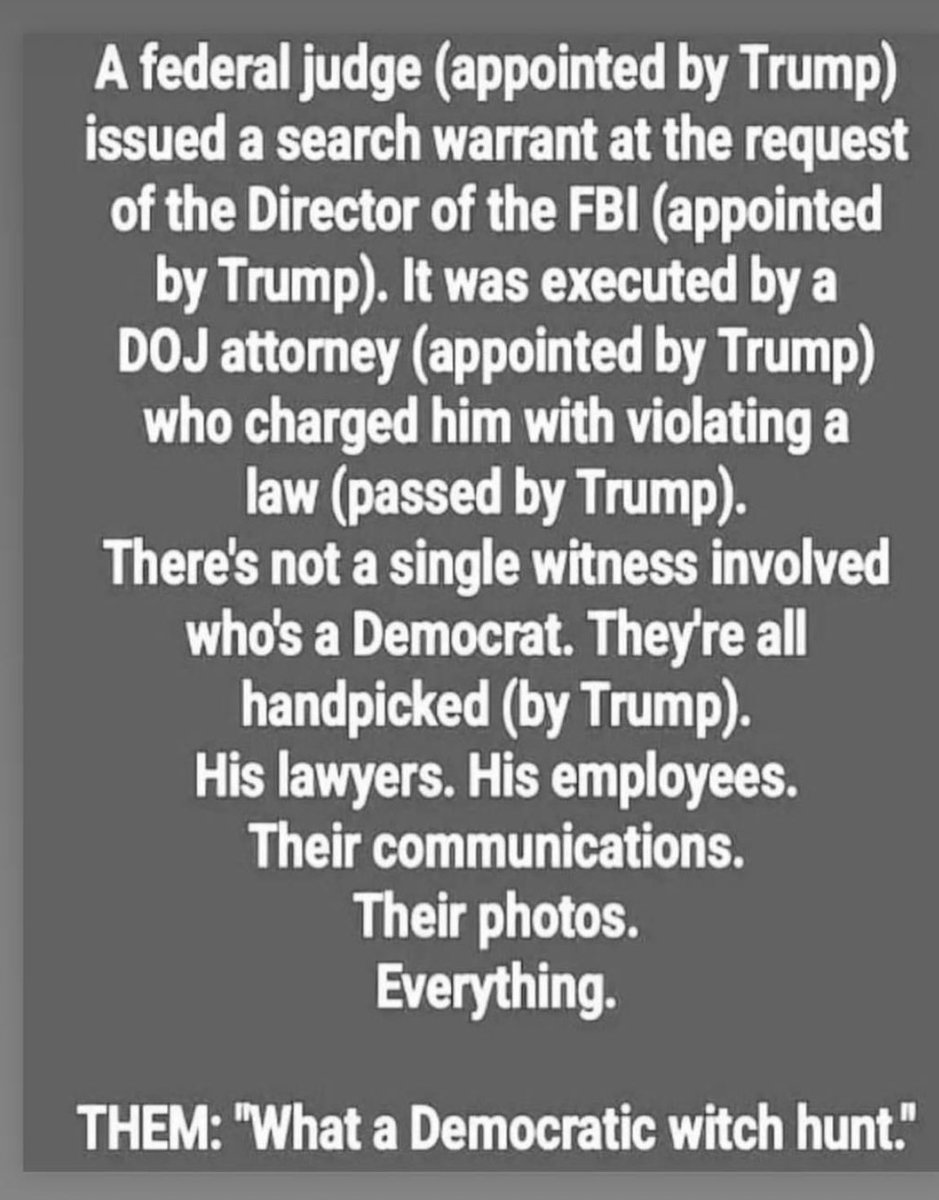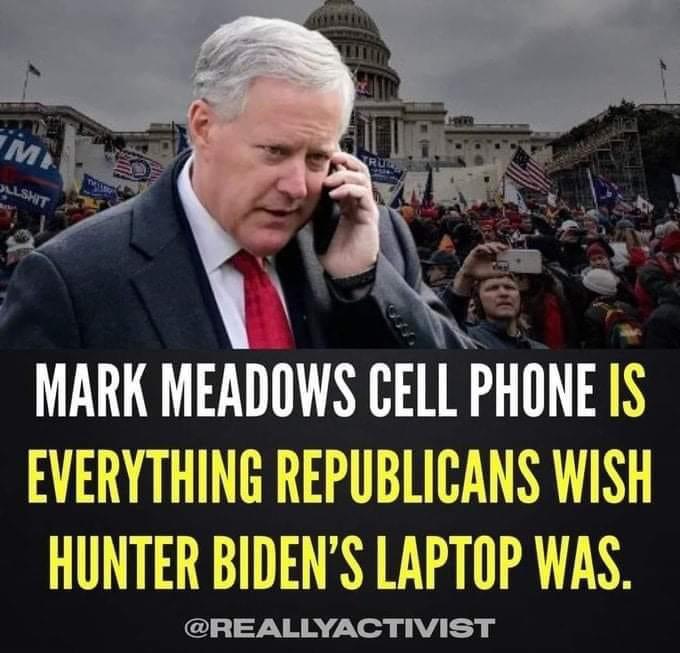
Author: clearandpresentdanger
Trump did it to himself

Erie PA auditorium was not even half-full for Trump (July 29)
Yikes! Donald Trump’s event in Pennsylvania has a ton of empty seats. This footage was taken during his speech. A very humiliating showing for Trump. pic.twitter.com/tLR1Ba5oC7
— MeidasTouch (@MeidasTouch) July 29, 2023
According to the Erie Insurance Arena, the venue has more than 9,000 seats and hosts the Ontario Hockey League team, the Erie Otters, as well as concerts and other community events. The official attendance has not yet been made public.
Arena officials announced today the attendance was just under 4,500.
Erie County PA population is 270,000. The PA population is 12.9 million. Trump drew 4,500.
Some truth for today




Trump, his supporters, and Republicans prove once again: They are trash, nothing but trash.
Cops forced to separate fighting Republican groups at their California state convention
California Republicans overhauled their delegate selection process today in a manner expected to help Donald Trump in 2024, the Los Angeles Times reported.
But the most interesting part of the story was what happened between two separate groups of pro-Trump protesters outside the event. Apparently confused by social media posts, they were denouncing the very action that the Trump campaign wanted.
And the best part is that they ended up trying to physically attack one another – outside a California Republican Party meeting at an Irvine hotel – until police intervened to cool them off.
Here’s how the Times reported the protest piece of the story.
“Tensions flared…with pro-Trump protesters denouncing the move (to change the delegate-selection process), police getting called and two factions nearly coming to fisticuffs,” the report said.
“Protesters wearing red ‘Make America Great Again’ caps and carrying American, Trump and ‘Don’t Tread on Me’ Gadsden flags gathered outside of the committee meeting, chanting Trump’s name and ‘America First!’ After they tried to enter the meeting and were blocked by security guards, Irvine police officers showed up and tried to cool emotions.”
The report continues:
“Later, two pro-Trump factions began screaming at each other, with one accusing the other of being white nationalists and the other responding that their foes supported open borders… They started jostling with one another and nearly came to blows until police stepped between the two groups.”
Trump shows his true colors, curses, swears at Biden and his trashy supporters go wild
Donald Trump referred to President Joe Biden on Saturday as a “dumb son of a bitch” at a rally.
The former president said well into his speech that his chief political opponent on the left side was “dumb” and then used the profane remark. Trump once made similar comments about fellow Republican Mitch McConnell, who recently froze for 20 seconds while addressing reporters.
Trump then mused about whether or not Biden would be the Democratic nominee. Trump asked the crowd if they believed Biden would be the nominee on the Democratic side, or if the GOP nominee would end up facing some identified person.Trump’s decision to ask the crowd about Biden was a pattern throughout the rally. Earlier in the same speech, Trump asked the crowd if they thought he should participate in the upcoming GOP debates. The crowd appeared to want him to attend, after which he said they just wanted that for the “entertainment” but that he has to also consider the “political” machinery.
Broadcast host interrupts rally, tells Trump’s piece-of-shit supporters to not listen to “kill ’em all” shouts
At least there is ONE Republican who is not a coward

Let us pause for a moment and consider “The Steele Dossier”
The Steele Dossier is a collection of observations and
anonymous witness accounts, known only to the collator,
Christopher Steele. At a later date, he provided the FBI with
details of some of his contacts.
The research was originally undertaken by Steele in a contract
capacity to FusionGPS, and was commissioned by the
Republican Party, funded by The Washington Free Beacon.
Later the research was undertaken by Steele/Orbis and was
funded by the Democratic National Convention (DNC), and the
Clinton Campaign. It was after this second operation that the
dossier was compiled.
At first, obtaining intelligence from Moscow went well. For
around six months—during the first half of the year – Steele was
able to make inquiries in Russia with relative ease. It got harder
from late July, as Trump’s ties to Russia came under scrutiny.
Finally, the lights went out. Amid a Kremlin cover-up, the
sources went silent and information channels shut down.
On his own initiative, Steele decided to also pass the
information to British and American intelligence services,
because he believed the findings were a matter of national
security for both countries.
It need be noted that the dossier was not the basis of the FBI
investigation, nor was it used by Mueller, although some small
reference was made to it.
The original investigation came about because Alexander
Downer, then Australia’s High Commissioner in London,
met socially with George Papadopoulos in London and
information from this meeting caused Downer concern enough
to alert the FBI. They then opened a counterintelligence
investigation into Russia’s attempts to disrupt the 2016 US
Presidential election, and whether there was any involvement
by Donald Trump’s associates.
NONE of the dossier contents has EVER been disproven. None. Not one.
Jack Smith’s superseding indictment puts another nail in Trump’s coffin
Former President Donald Trump faces new charges in connection with his post-presidency handling of classified documents after the special counsel filed a new indictment Thursday.
The federal indictment, filed in the Southern District of Florida, alleges that Trump was part of a scheme to delete security video and that a newly charged defendant — who was identified as a property manager at Trump’s Mar-a-Lago residence — told another employee that “the boss” wanted the server deleted.
That employee, Carlos De Oliveira, who was a maintenance supervisor at Mar-a-Lago, was charged Thursday. His lawyer, John Irving, declined to comment.
Court documents say De Oliveira denied that he was involved in moving boxes. “Never saw anything,” he told the FBI, according to documents. “Never saw anything,” he repeated.
The indictment lays out what federal authorities say was a scheme to obstruct the ongoing investigation. Trump was very focused on not allowing officials to get their hands on his boxes, it indicates.
“I don’t want anybody looking, I don’t want anybody looking through my boxes, I really don’t,” Trump told his lawyer in May 2022, according to the indictment. “What happens if we just don’t respond at all or don’t play ball with them? Wouldn’t it be better if we just told them we don’t have anything here?”
Trump’s lawyer said Trump later made a “plucking motion” to suggest that he should take anything that was “really bad” out. Afterward, prosecutors suggest, Trump was involved in an effort to delete security camera video that would show how his employees had moved boxes of documents before the FBI search.
The superseding indictment claims that Nauta and De Oliveira met up at a security guard booth where security video was displayed on monitors and that De Oliveira later stepped into an audio closet with another employee and had a conversation that De Oliveira said should be kept between them.
De Oliveira asked the employee how long the server retained video, and the other employee indicated it was about 45 days, according to the indictment. De Oliveira said that “the boss” wanted the server deleted, but the employee responded that he did not believe he would have the right to do that and would need to speak with the supervisor of security, the indictment says.
De Oliveira reiterated that “the boss” wanted it done and asked, “what are we going to do?” according to the indictment.
That conversation took place in late June 2022, just a few weeks before the FBI searched Mar-a-Lago, the indictment says. After the search, it alleges, Nauta called another Trump employee and asked about De Oliveira. The unnamed Trump employee told Nauta that De Oliveira was loyal and would not do anything to affect his relationship with Trump, according to the indictment.
Nauta later wrote in a Signal chat with the representative of a Trump PAC that De Oliveira was loyal, and Trump later called De Oliveira and told the maintenance worker that Trump would get him a lawyer, the indictment says.
Trump’s bluster and bluff works in civil cases, will not work in criminal cases
No one knows more about manipulating this country’s legal system than Donald Trump. As a favored protege of the infamous and despicable New York lawyer Roy Cohn, who built a successful career ruining other peoples’ lives as Sen. Joe McCarthy’s ruthless sidekick in the 1950’s, Trump learned early on how to abuse the legal system as a tool of intimidation against his enemies.
For those unfamiliar with the sheer scale of Trump’s litigiousness, the title of a 2019 book by attorney James D. Zirin, “Plaintiff in Chief: A Portrait of Donald Trump in 3500 Lawsuits” says it all. As David Fahrenthold, in his 2019 Washington Post review of Zirin’s book, summarizes:
…Zirin argues that Trump learned to see the law as Cohn did: “not as a system of rules to be obeyed . . . but as a potent weapon to be used against his adversaries.” Trump sued often but rarely won big. Winning in court wasn’t always the point: The lawsuit itself was the thing, a tool of intimidation cloaked in legalese, an outgoing missile that left your enemies buried in costs and hassle. That approach had costs for Trump, too. But he could bear them. He lost friends, wives, lawyers and business partners — but always found new ones, who thought their fate would be different.
That lesson — to weaponize the legal process as much as possible — likewise applied whenever Trump found himself on the receiving end of litigation. Jack Shafer, senior media writer for POLITICO (also referencing Zirin’s account) notes that “Cohn taught Trump to counterattack; undermine his adversary; work the press; lie, lie and lie again; and even in the case of a loss or forced to settle, claim victory and go home.”
However, as Shafer observes, the “Roy Cohn strategy” that Trump has so successfully employed in escaping serious civil liability over the course of his career does not translate well in the criminal arena, which is where Trump finds himself navigating today.
Shafer notes that “[T]he Cohn rules, which can work so brilliantly in civil court, don’t carry the same weight in criminal cases.”
The biggest practical difference between civil and criminal prosecutions is that remedies in civil cases are financial penalties or injunctions. This is the padded playroom in which Trump has cavorted his entire professional life…[.]
But criminal cases don’t pit one person or organization against another. They are reserved for crimes against the state or society, and the plaintiff isn’t Joe or Doris or some regulatory body, it’s the big, angry fist of government. When you lose in this venue, you don’t write a check. You’re often sentenced to prison.
In short, if he hasn’t already realized it, Trump is soon going to find out that his favored tactics of wearing down the opposition with bluster, threats and expensive, crippling countersuits are simply inapplicable in a criminal setting. As Shafer observes, “Prosecutors seek justice, not compromise, and they’re relatively immune to the field disturbances that rattle civil litigators.”
In Shafer’s view, the biggest “tell” that reveals Trump’s over-arching, Roy Cohn-style mindset is the fact that he voluntarily put himself in peril in connection with the obstinate retention of those classified government documents. As Shafer notes:
If, when contacted by authorities, he had simply returned the documents, he would have suffered not at all, like Joe Biden and Mike Pence, who quickly complied when their poor document hygiene became known. Trump’s problem is that he would rather fight the law even when there is no reason to fight. He turned down multiple opportunities to return the docs. Instead, he prevaricated with a grin as if he were dodging some New York City building inspector.
According to Shafer, what Trump failed to comprehend is that his reflexive, “I can get away with anything” attitude that’s worked so well for him over the past fifty years doesn’t provide the same options when the subject is criminal guilt or innocence. The opportunity to bury your opponent with onerous expenses (or just refusing to pay a judgment by filing for bankruptcy) is simply not a viable tactic, as it would be in a civil case. Nor is the opportunity available to appeal an adverse verdict with the strategy of negotiating it down, as often occurs in civil litigation. Trump can appeal any criminal conviction, of course, but unless and until that conviction is reversed, a convicted criminal he remains.
Even so, Trump may justifiably believe that he can steamroll an obviously biased Aileen Cannon, the Florida district judge currently presiding over the classified documents charges. Leaving aside whether he manages to negotiate a plea bargain in that case (a distinct possibility), it’s by no means certain whether Cannon would ever countenance a jail sentence. He also is unlikely to receive a trip to prison on the “hush money” case currently pending in the Supreme Court of New York, assuming he is convicted. While his guilt in both of those cases appears fairly patent, his exalted position as a former president may come into play in both circumstances.
But by summer’s end he will likely be facing at least two additional (and more serious) criminal indictments relating to his efforts to overturn the 2020 election, filed by Special Counsel Jack Smith as well as Fulton County GA prosecutor Fani Willis. Both of these prosecutors have demonstrated their relative indifference to Trump’s usual shenanigans, and both doubtlessly by now have been threatened so many times by Trump’s rabid supporters that they’ve likely been rendered impervious to any coercion or intimidation, public or private.
Of course, Trump thinks he can run out the clock, like he’s always done in civil matters. In fact, that appears to be his only strategy: To regain the White House, have a compliant and hand-picked Justice department dismiss all his federal criminal charges (but, significantly, not the state-based ones); or, if one of the cases actually sees trial before the 2024 election, perhaps throw his support behind a DeSantis or some other Republican in exchange for a promised pardon. But as Shafer points out, while certainly possible, none of these strategies are particularly attractive or even promising, particularly given the baggage that multiple indictments (or convictions) will carry with a majority of the voting public.
Rather, the fact that Trump finds himself in this predicament in the first place suggests that his reliance on Roy Cohn’s nefarious strategy and tactics may have finally exceeded its shelf life.
Rudy Giuliani admits it HE LIED AND LIED AND LIED ABOUT TWO GEORGIA ELECTION WORKERS
Former Trump lawyer Rudy Giuliani has admitted in a court filing that he made false claims about Ruby Freeman and Shaye Moss, two Georgia election workers who were falsely accused of committing election fraud by former President Donald Trump and his allies.
As Politico’s Kyle Cheney reports, Giuliani made the admission in a new court filing in an attempt to ward off further discovery in the case.
“Rudy’s stipulation appears intended to ward off further legal pain in this long-running defamation lawsuit,” Cheney writes. “Judge Howell has already sanctioned him and threatened further penalties for failing to produce docs… He doesn’t concede to any damages and still says he has legal defenses to the claims in the lawsuit — but as a factual matter, he admits he said what he said, that it was false and that it could constitute defamation/intentional infliction of emotional distress.”
Giuliani has been facing the prospect of severe sanctions after attorneys representing Freeman and Moss argued that he failed to turn over electronic communications he made despite having had ample time to produce them.
“Defendant Giuliani has had eighteen months since Plaintiffs first filed this suit to take reasonable steps to preserve his electronic evidence, including more than six months since Plaintiffs first raised the question of preservation,” the attorneys argued earlier this month. “Defendant Giuliani has had nearly three months since Plaintiffs filed the motion to compel. Defendant Giuliani’s failure to preserve his electronic records in the face of repeated reminders, and a personal awareness of his obligations, can and should be interpreted by this Court as a deliberate effort to deprive Plaintiffs of material evidence in this litigation.”